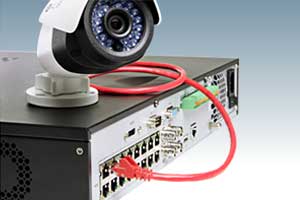7 Questions to Ask When Buying a Network IP Video Security System

Network IP video surveillance systems offer many advantages over analog CCTV systems, such as multi-megapixel resolution and integration into existing networks. As a result, they are in high demand for monitoring businesses of all sizes.
When choosing an IP video security system, here are 7 questions to ask before you buy, in order to get the optimal performance out of your investment:
- Which security camera features are most important?
- How much image resolution do I need?
- How will I power my cameras?
- What devices do I need my video security system to integrate with?
- How much network bandwidth will my surveillance system require?
- How much hard drive storage space will I need?
- What are my future surveillance needs?
1. Which Security Camera Features Are Most Important?
You can take advantage of the many benefits of IP technology by choosing an IP security camera that is equipped with your desired features, along with an NVR that supports these features.
Most IP-based cameras offer advanced features such as multiple video compression options, motion detection, wide dynamic range (WDR), 3D digital noise reduction (3D-DNR), alarm inputs and outputs, and video analytics. Choosing IP cameras equipped with advanced features allows you to broaden the capabilities of your system via yours cameras, versus relying solely on the features built into your recorder.
For example, IP cameras that carry out motion detection and video analytics reduce the workload on the NVR by not requiring the recorder to perform these processing functions.
Some IP-based cameras also offer internal storage through micro SD card slots for standalone or redundant storage of video.
Determine which security camera features are right for your application, and choose the cameras accordingly.
2. How Much Image Resolution Do I Need?
IP cameras are digital end to end, and use progressive scanning to make full use of camera imagers. In fact, IP cameras deliver up to 25% more resolution than analog cameras with similar imagers. IP systems also support megapixel cameras, delivering crisp, detailed, high-definition real-time video.
Choosing an IP camera with the right resolution for your application is essential. Resolution needs are unique to every location and security application.
For some, a 2.0 megapixel camera will be sufficient for capturing the level of detail needed for the application, while others may need a camera that offers a higher resolution.
For example, if you need to capture a high level of detail for facial identification or license plate recognition, you’ll want a higher-resolution camera (such as a 5.0 megapixel camera) that can cover larger areas to achieve this.
However, it’s important to note that there is a tradeoff for obtaining high resolution images. A higher-resolution camera will have slightly less low light performance.

3. How Will I Power My Cameras?
Many IP security cameras are equipped with Power over Ethernet (PoE) and use Ethernet cables to carry both power and data. This reduces cabling costs and simplifies installation.
If your IP camera does not have PoE, you’ll need to use a separate power cable to power it.
4. What Devices Do I Need My Video Security System to Integrate With?
Many IP video systems feature video management software (VMS) that integrates with compatible external devices such as alarm systems, lighting, environmental temperature controls and access control systems.
If you have external devices you would like to connect to your video security system, you’ll want to make sure the devices are compatible with the VMS you are considering.
Systems integration enables you to connect your IP surveillance system to an external device, such as access control system. In this example, the devices can communicate and interact over the network, providing video and access control functionality managed through a single interface.
Many IP security systems conform to ONVIF (Open Network Video Interface Forum) specifications for IP-based security products. ONVIF defines a common protocol for the exchange of information between different network video devices from different manufacturers, to allow greater interoperability in multi-vendor network video systems. This gives you greater compatibility with more IP-based devices.
It is a good idea to refer to the recording software’s list of compatible devices and note that compliance testing is still required to ensure full operational compatibility.

5. How Much Network Bandwidth Will My System Require?
When choosing an IP security system, bandwidth is a very important consideration. Network IP camera systems require considerable network bandwidth in order to transmit high-resolution video.
IP cameras use video compression to reduce video file size and optimize network bandwidth and storage capacity, while maintaining image quality.
Bandwidth can become an issue as more security cameras are added to the network and higher-resolution images are transmitted. The more cameras you have connected to your network, the greater your bandwidth requirements.
High-resolution cameras also require more bandwidth. Learn how to estimate bandwidth requirements with our Network IP Security System Bandwidth Calculator.
Having a separate dedicated network for your IP security system will ensure that your video surveillance equipment will have the bandwidth needed to perform, without affecting other business functions on your network.

6. How Much Hard Drive Storage Space Will I Need?
Having sufficient hard drive storage capacity is essential for your IP security camera system. It’s important to estimate upfront how much hard drive storage space you will need based upon the requirements of your security application. Many people are surprised by how much hard drive storage high-resolution video takes up.
It’s important to note that factors such as video compression (codec), resolution and motion detection recording all influence an NVR’s hard drive storage capacity, as well as the number of days the NVR will store information.
Choosing more hard drive storage space than you think you may currently need will ensure that you don’t miss critical events and will scale to support future recording needs, by allowing you to add cameras in the future.
If you need help determining hard drive storage, you can use our NVR Storage Calculator for Network IP Security Cameras.
7. What Are My Future Surveillance Needs?
Scalability is another important consideration when choosing a network IP system. An IP-based surveillance system should enable you to easily add more cameras to your network as your security needs grow.
When it comes the scalability, the majority of NVRs are cost-structured to add additional cameras via a per camera license. This can get expensive, because if you want to add more cameras to the NVR at a later date, you are required to purchase an additional camera license for each camera you want to add to recording device, and those camera licenses can really add up.
However, some NVRs offer an open IP license. With an open IP license, all video channels come pre-licensed and fully-enabled, allowing you to add cameras as your system needs require (up to number of max channels supported per system), without having to purchase additional licenses. An open IP license provides you with the flexibility and the scalability to expand and reduces the total cost of ownership over the life of the product.
Asking the above 7 questions before purchasing an IP video security system will help you take advantage of the many benefits of IP technology, and ensure that you get the optimal performance out of your investment.



